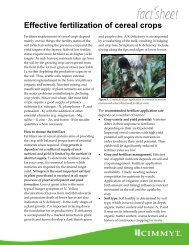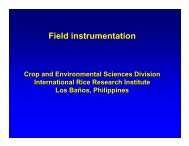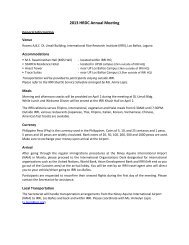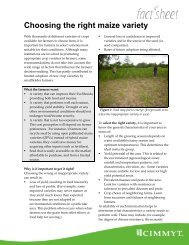Cop<strong>in</strong>g with water scarcity3In this chapter, we present technology options tohelp farmers to cope with water scarcity at the fieldlevel. The way to deal with reduced (irrigation orra<strong>in</strong>) water <strong>in</strong>flows to <strong>rice</strong> fields is to reduce thenonproductive outflows by seepage, percolation, orevaporation, while ma<strong>in</strong>ta<strong>in</strong><strong>in</strong>g transpiration flows(as these contribute to crop growth). This can bedone at land preparation, at crop establishment, anddur<strong>in</strong>g the actual crop growth period.3.1 Land preparationLand preparation lays the foundation for the wholecropp<strong>in</strong>g season and it is important <strong>in</strong> any situationto “get the basics right.” Especially important forgood water <strong>management</strong> are field channels, landlevel<strong>in</strong>g, and tillage operations (puddl<strong>in</strong>g, and bundpreparation and ma<strong>in</strong>tenance).3.1.1 Field channelsMany irrigation systems <strong>in</strong> Asia have no fieldchannels (or “tertiary” irrigation or dra<strong>in</strong>age channels)and water flows from one field <strong>in</strong>to the otherthrough breaches <strong>in</strong> the bunds. This is called “plotto-plot”irrigation. The amount of water flow<strong>in</strong>g<strong>in</strong> and out of a <strong>rice</strong> field cannot be controlled andfield-specific water <strong>management</strong> is not possible.This means that farmers may not be able to dra<strong>in</strong>their fields before harvest because water keepsflow<strong>in</strong>g <strong>in</strong> from other fields. Also, they may not beable to have water flow<strong>in</strong>g <strong>in</strong> if upstream farmersreta<strong>in</strong> water <strong>in</strong> their fields or let their fields dryout to prepare for harvest. Moreover, a number oftechnologies to cope with water scarcity requiregood water control for <strong>in</strong>dividual fields (Chapter3.5). F<strong>in</strong>ally, the water that cont<strong>in</strong>uously flowsthrough <strong>rice</strong> fields may remove valuable (fertilizer)nutrients. Construct<strong>in</strong>g separate channels to conveywater to and from each field (or to a small groupof fields) greatly improves the <strong>in</strong>dividual control ofwater and is the recommended practice <strong>in</strong> any typeof irrigation system.3.1.2 Land level<strong>in</strong>gA well-leveled field is a prerequisite for good crophusbandry. When fields are not level, water maystagnate <strong>in</strong> depressions, whereas higher parts maybecome dry. This results <strong>in</strong> uneven crop emergenceand uneven early growth, uneven fertilizer distribution,and maybe extra weed problems. Informationon technologies for land level<strong>in</strong>g can be found atwww.knowledgebank.irri.org.3.1.3 Tillage: reduc<strong>in</strong>g soil permeabilitySeepage and percolation flows from <strong>rice</strong> fields aregoverned by the permeability (hydraulic conductivity)of their soils: their capacity to conduct waterdownward and sideward (Chapter 1.3). A <strong>rice</strong> fieldcan be compared to a bathtub: the material of a bathtubis impregnable and it holds water well—however,if you have only one hole (by remov<strong>in</strong>g theplug), the water runs out immediately. <strong>Rice</strong> fieldsjust need a few rat holes or leaky spots and they willrapidly lose water by seepage and percolation.Large amounts of water can be lost dur<strong>in</strong>gsoak<strong>in</strong>g prior to puddl<strong>in</strong>g when large and deepcracks are present that favor rapid “by-pass flow”to below the root zone. Cabangon and Tuong (2000)showed the beneficial effects of additional shallowsoil tillage before land soak<strong>in</strong>g to close the cracks:the amount of water used <strong>in</strong> wet land preparationwas reduced from about 350 mm to about 250 mm(Fig. 3.1).17
<strong>Water</strong> <strong>in</strong>put (mm)400350300250200150100500ControlCracks plowedFig. 3.1. Effect of shallow tillage to fill cracks before soak<strong>in</strong>gon water <strong>in</strong>put dur<strong>in</strong>g land preparation, Bulacan, Philipp<strong>in</strong>es.Data from Cabangon and Tuong (2000).<strong>Water</strong> <strong>in</strong>put (mm)2,0001,8001,6001,4001,2001,0008006004002000No l<strong>in</strong><strong>in</strong>gRa<strong>in</strong>fallIrrigationL<strong>in</strong><strong>in</strong>gFig. 3.2. Effect on total water <strong>in</strong>put of l<strong>in</strong><strong>in</strong>g bunds withplastic <strong>in</strong> a field experiment at IRRI, Los Baños, Philipp<strong>in</strong>es.Data from Bouman et al (2005).Thorough puddl<strong>in</strong>g results <strong>in</strong> a good compactedplow sole that reduces permeability and percolationrates throughout the crop grow<strong>in</strong>g period(Chapter 1.3; De Datta 1981, Tuong et al 1994).The efficacy of puddl<strong>in</strong>g <strong>in</strong> reduc<strong>in</strong>g percolationdepends greatly on soil properties. Puddl<strong>in</strong>g maynot be effective <strong>in</strong> coarse soils, which do not haveenough f<strong>in</strong>e clay particles to migrate downwardand fill up the cracks and pores <strong>in</strong> the plow sole.On the other hand, puddl<strong>in</strong>g is very efficient <strong>in</strong> claysoils that form cracks dur<strong>in</strong>g the fallow period thatpenetrate the plow pan (Tuong et al 1994). Althoughpuddl<strong>in</strong>g reduces percolation rates of the soil, theaction of puddl<strong>in</strong>g itself consumes water, and thereis a trade-off between the amount of water used forpuddl<strong>in</strong>g and the amount of water “saved” dur<strong>in</strong>gthe crop growth period by reduced percolation rates.Puddl<strong>in</strong>g may not be necessary <strong>in</strong> heavy clay soilswith low vertical permeability or limited <strong>in</strong>ternaldra<strong>in</strong>age. In such soils, direct dry seed<strong>in</strong>g on landthat is not puddled but tilled <strong>in</strong> a dry state is verywell possible with m<strong>in</strong>imal percolation losses (Tabbalet al 2002; Chapter 3.2).Soil compaction us<strong>in</strong>g heavy mach<strong>in</strong>eryhas been shown to decrease soil permeability <strong>in</strong>sandy soil with loamy subsoils with at least 5%clay (Harnpichitvitaya et al 2000). Although mostfarmers cannot afford to compact their soils, thistechnology may be feasible on a large scale withgovernment support.3.1.4 Bund preparation and ma<strong>in</strong>tenanceGood bunds are a prerequisite to limit seepageand underbund flows (Tuong et al 1994). To limitseepage losses, bunds should be well compactedand any cracks or rat holes should be plasteredwith mud at the beg<strong>in</strong>n<strong>in</strong>g of the crop season.Make bunds high enough (at least 20 cm) to avoidoverbund flow dur<strong>in</strong>g heavy ra<strong>in</strong>fall. Small leveesof 5–10-cm height <strong>in</strong> the bunds can be used to keepponded water depth at that height. If more waterneeds to be stored, it is relatively simple to closethese levees. Researchers have used plastic sheets <strong>in</strong>bunds <strong>in</strong> field experiments to reduce seepage losses.For example, Bouman et al (2005) demonstrateda reduction of 450 mm <strong>in</strong> total water use <strong>in</strong> a <strong>rice</strong>field by l<strong>in</strong><strong>in</strong>g the bunds with plastic (Fig. 3.2).Although such measures are probably f<strong>in</strong>anciallynot attractive to farmers, the author came upon afarmer <strong>in</strong> the Mekong Delta <strong>in</strong> Vietnam who usedold plastic sheets to block seepage through veryleaky parts of his bunds.3.2 Crop establishmentM<strong>in</strong>imiz<strong>in</strong>g the turnaround time between landsoak<strong>in</strong>g for wet land preparation and transplant<strong>in</strong>greduces the period when no crop is presentand when outflows of water from the field do notcontribute to production. Especially <strong>in</strong> large-scaleirrigation systems with plot-to-plot irrigation, waterlosses dur<strong>in</strong>g the turnaround time can be very high.For <strong>in</strong>stance, <strong>in</strong> the largest surface irrigation scheme<strong>in</strong> Central Luzon, called UPRIIS (Upper PampangaRiver Integrated Irrigation System), it took up to63 days <strong>in</strong> a contiguous 145-ha block from the firstday of water delivery for land preparation until thewhole area was completely transplanted (Tabbalet al 2002). The total amount of water <strong>in</strong>put dur-18
- Page 2: Water Management in Irrigated Rice:
- Page 5 and 6: PrefaceWorldwide, about 79 million
- Page 8 and 9: Fig. 1.2. Water balance of a lowlan
- Page 10 and 11: given in Table 1.1. Water losses by
- Page 14 and 15: Distribution (%)1009080706050403020
- Page 16 and 17: The plant-soil-water system22.1 Wat
- Page 18 and 19: Ψ Air-100 MPaDemandLeafXylemStemRo
- Page 20: tive to water deficit than cell enl
- Page 25 and 26: Table 3.1b. Yield, water input, and
- Page 27: Grain yield (t ha -1 )98A2002 20037
- Page 30 and 31: Table 3.5. Water input (I = irrigat
- Page 32 and 33: Practical implementationTemperate e
- Page 34 and 35: Practical implementationSpecific in
- Page 36 and 37: Table 3.8. Comparison of water use
- Page 38: Flooded yield (t ha -1 )87A65432102
- Page 41 and 42: consumption (Hamilton 2003). Many t
- Page 44 and 45: Irrigation systems55.1 Water flows
- Page 46 and 47: the main system is supply-driven, f
- Page 48 and 49: Table 5.1. Area, water use, and tot
- Page 50 and 51: Appendix: InstrumentationDetailed d
- Page 52: 0.5 cm in diameter and spaced 2 cm
- Page 55 and 56: Bronson KF, Singh U, Neue HU, Abao
- Page 57 and 58: Lampayan RM, Bouman BAM, De Dios JL
- Page 59: Uphoff N. 2007. Agroecological alte





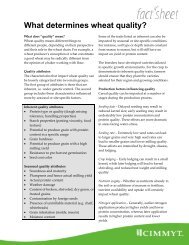

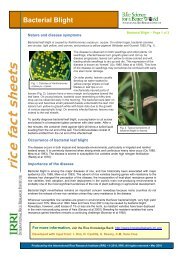

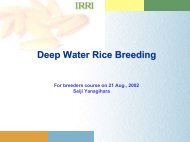
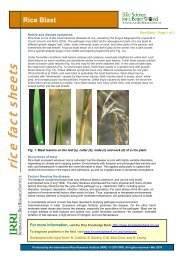
![International Standards' Organization â Rice Specification [ISO 7301]](https://img.yumpu.com/36696862/1/190x245/international-standards-organization-a-rice-specification-iso-7301.jpg?quality=85)

